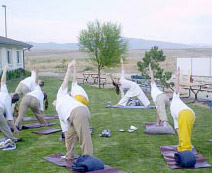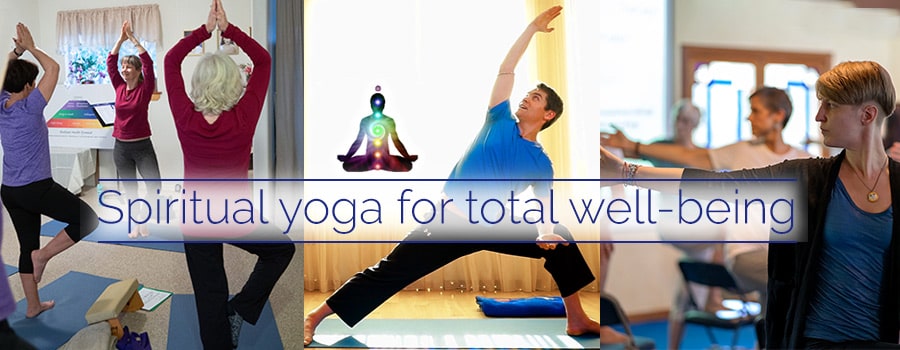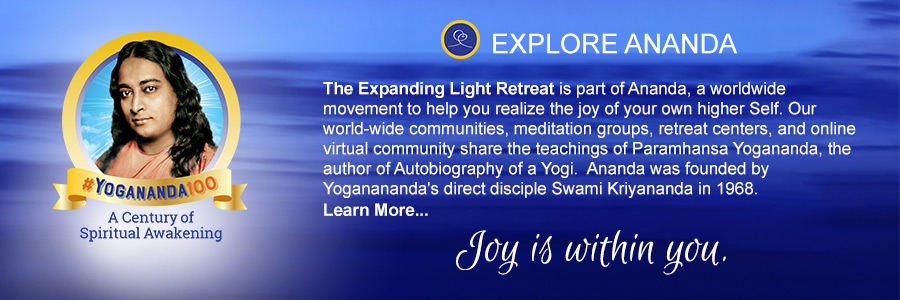Ananda Yoga Comes to a Women’s Prison
An Interview with Nikki Weihe
Nikki has been teaching Ananda Yoga® in Boise, Idaho at the South Boise Women’s Correction Center for nearly two years. Here is the story of her adventure.
Nikki also gives private yoga instruction in clients’ homes. Her teaching business is called Blue Flower Yoga. Nikki also gives private yoga instruction in clients’ homes.
Gyandev
How did you start teaching in a prison?
Nikki
After Ananda Yoga Teacher Training in August 2002, it came to me in meditation that I needed to teach free yoga in the prison system. I heard it loud and clear.
So I made some calls, and a friend whose brother and sister-in-law are both judges in Idaho connected me with a person who worked for the Department of Corrections, who helped me reach the volunteer coordinator, who was excited about the idea of me bringing yoga to the Idaho Department of Corrections. Within a month I was scheduled for prison volunteer training. They decided to put the yoga program under the Religious Services category.
Administration didn’t want aerobic activity, but were interested in the spirituality of yoga. I consider it an honor that the work is identified as spiritual, not just exercise. I went to the volunteer training with Christians, Catholics, and Buddhists.
“In yoga we learn how to focus our minds to a certain thing, and then
mentally see it through. Learning
this has helped show me how to set a
goal mentally, and achieve it physically.”
—Rachel, inmate
Next, I met with the chaplain at the medium security section of the prison. The chaplain and administrators decided I should get my “prison legs” at the women’s facility next door. I was a little disappointed because I thought I was going to start right then, and hadn’t even considered teaching women inmates.
I said “OK, I’ll go with that, but you need to call them right now, because I’m here and I’m ready.” The call was made and the response was, “Send her right over.” The women’s facility staff asked, “You want to teach here?” “It’s my karma yoga,” I said. “I want to come here and do sadhana, my spiritual practice, with your women.” They asked, “When can you start?” I checked my appointment book and answered, “November 1.”
Now every Friday between 7:30 and 9:00, twenty women practice sadhana [yoga and meditation]. It’s been a rousing success. There is always a waiting list with upward of twenty women. Last month there were forty. Unfortunately, because of prison scheduling, we cannot get a full two hours of practice time. Consequently, meditation suffers. The students really need the physical portion of practice.

Nikki onsite and dressed for her karma yoga offering
However, I also lead an Ananda meditation group that meets every other Thursday morning. The meditation group also practices Energization Exercises. Some of the same people do both groups, but many of the regular yoga students are in other classes on Thursday mornings. Some women in the meditation group have quit sadhana practice; the full practice, with the asanas, was too much for them.
Gyandev
Describe the classroom and your very first class.
Nikki
We meet in the recreation room, which is in the center of the facility. Staff and I decided that twenty students could fit into the space. A signup list was started and on November 1st, the room was packed. All the students brought their blanket and wore comfortable clothes.
Off to each side of the practice room are two tiers. Windows go all the way around, so people can see in. There is a lot of noise. When prison announcements are made, we hear them through the loud speakers. The distraction is part of the practice, their karma and mine.
Our practice space is like being in a fish bowl. The first time we practiced, the women faced the windows to the halls. Other prisoners and staff can and do stare in, creating constant distractions. After that first night we changed positions, so the students look out toward the mountains, and I look out and see the passersby.
That first night — and nearly every other Friday night since then — we talked about the importance of developing our own sadhana. I explained about Paramhansa Yogananda and Energization Exercises, chanting, and preparing the mind and body for meditation. I touched on what Ananda means to me, how Ananda changed my life, how much I love God, and explained that bringing sadhana to them in this way is karma yoga. I told them I was happy to be there.
The students sat and listened. We had an abbreviated sadhana: the entire set of Energization Exercises, a few asanas, and a few minutes of sitting. That first night we chanted “Aum Namah Shivaya,” a cappella and a little off key. It was good. This summer we are being allowed to practice outside. This is a big privilege for the women in both the meditation group and in sadhana group. There’s nothing like doublebreathing fresh air! Believe me, these people comprehend their good fortune in having this outdoor experience, and they put a high value on it. It is unlike anything else they are allowed to do in prison!
Gyandev
Do the students catch on to the Energization Exercises?
Nikki
Yes, Energization is the joy of our practice. Once in a while, if we’re short on time, we leave them out, go on with the other practices and have a longer meditation.
Sometimes I just go with the flow and change the practice a bit. It doesn’t happen often though, as Energization has proved to be an incredible tool for these women. They learn to direct their mind and energy in ways they’ve never known before, and it seems to really inspire confidence in them.
Turnover happens, and new people come. Each week a few veteran members leave and an equal number of new students replace them. Students leave because they’ve been discharged, or moved, or perhaps for other reasons. There is a challenge when teaching Energization Exercises to new students.
Continuing students are anxious to get into their practice. Time is short — only 90 minutes — and continuing students want the entire practice. The new students catch on pretty quickly by watching the others.
The women learn that the Energization Exercises are a pranayama technique designed by Yogananda, and the importance of including pranayamain a solid raja yoga practice.
Gyandev
Tell us about the ages and physical condition of the students.
Nikki
Most of the women are in their twenties. Some are in their midforties, a few over fifty. Some have arthritis. One was an amputee.
Her arm was amputated at the elbow. She was undaunted and tried everything. She just did it! During the circle of joy she pushed through, around, up and back. While in table position, when reaching out opposite arm and leg, she balanced on her stump. She did downward dog with one arm! She was an inspiration for others, especially those who moan and groan during asana.
For the most part, the women are strong. Many of the women are quite flexible. I had one student who was able to do a beautiful Natarajasana. She’d never done it before, but I had a feeling she could pull it off and she did — with ease. It brought tears to my eyes. This is someone whose only exposure to asanahas been in prison. She was exceptional, but many of the women show incredible perseverance!
Gyandev
Is there anything different about teaching yoga to felons?
Nikki
These women have an innocence about them that is hard to put your finger on. They made poor decisions, like all of us, but they’ve ended up in this place. You can see they want something else and are searching for a path, just like anybody. Their eyes sparkle, and I can see God there. I don’t think about them as felons. I love them, that spark of God in them.
I remind these women that we create our own reality, that they are all powerful people. I tell them “Look at what you’ve created. You did it all yourself. It’s amazing. Look at everything you’ve done to create this world for yourself. You can do that again but in a more positive way. Your karma — the actions you’ve taken, the thoughts you’ve had, have brought you here. Not everybody can live like this. Not everybody is strong enough inside to withstand this life that you’ve created for yourself. It’s a real call to spirit. You have to go through and endure this to get to the next stage. Not everybody can go to prison. You are powerful spiritual beings.”
When we roll onto our right side, from Savasana, I lead a meditation from Metaphysical Meditations. I let my hand open the book and see where it goes. The passage may be about love, or about how they can meditate more deeply. I read that thought to them and sometimes go on with what inspires me. Those positive spiritual messages are in their heads when we sit up and chant. Sometimes they ask me to chant to them while they sit, focused on the spiritual eye, the Ajna Chakra.
Sanskrit is very healing. After chanting, we meditate, sometimes as little as ten minutes, but we try to do more. Every class ends with Divine Mother’s Healing Prayer. It is a magnificent way to end sadhana.
Most of the women at the correction center have at least one child from whom they are separated, and the healing prayer has a unique way of bringing peace to troubled hearts.
Gyandev
Does some prison official watch the sadhana?
Nikki
They can see us through the window from the control center, but it’s not like they’re actually watching the class all the time. There is a lot of activity for the corrections officers to watch. Inmates are walking around, using phones and asking questions. They have to ask permission for everything!
Then there’s pill call: tier one and tier two pill call. Some women have to leave class to get prescribed medications — antidepressants and such. It’s loud in there. The loudspeaker blasts out, “TIER ONE PILL CALL.” We just keep going. There is also a large ice machine in the room. By the end of the day, the ice has been used up, so the clatter is really loud as the machine works overtime, dumping ice. KAH CHUM! KAH CHUM!
The noise becomes part of the practice. The students tell me they block it out. I say: “Well, that’s good. If you can learn to meditate in this environment, you can meditate anywhere!”
One noise really angered them a while back. The class was in Savasana, which to them is very sacred time. They love it. This is their three to four minutes of alone time. One of the other inmates outside the practice room walked by and rapped really hard on the window. It was an unusually disruptive sound, and it jolted the class. They launched huge complaints. There was a big investigation. I had seen who did it. She came in the next week and apologized to the class.
Gyandev
Do you teach them to meditate, or do you simply have quiet time or visualization?
Nikki
We cover Hong-Sau, but we go into it more deeply in the meditation group. During sadhana, meditation is mostly quiet time; we watch the breath. I don’t want to talk too much because they have so little quiet time. I affirm with them, “Bones, muscles, movement, I surrender now …,” and that’s it! I say a silent prayer of thanks for being able to serve in this way. Seeing those women in Savasana is beautiful.
The inmates sleep on metal beds with thin mattresses. I hear about their beds so often that I call the stories, “The Legend of the Metal Bed.” Friday night, after practice, is always their best night of sleep on these beds. The peacefulness carries into their evening and weekend.
They often tell me that, for this one night a week, they don’t feel incarcerated. The affirmation “I am free! I am free!” has even more meaning than we on the outside can imagine.
Gyandev
It’s fascinating that you teach this more as a sadhana — with some instruction, but primarily experiential.
Nikki
Yeah, the name of the class is “Yoga: A Spiritual Path for Women Incarcerated.” Often, we take time in the beginning to talk about yoga philosophy. Patanjali’s Yoga Sutras, yamas, niyamas, ashtanga yoga, the complete science of Raja Yoga. I tell them, “Let me warn you: when you get out and go to a yoga class, it’s not going to be like this class.” I tell them about books that can help them continue the practice, and we talk about Ananda. I encourage them to look at the Karma Yoga program at The Expanding Light.
Most people don’t realize the spiritual opportunities that are available in this country. A simple trip to a spiritual retreat can send a seeker on a path never before imagined! I’m certain many Ananda certified teachers can attest to that fact!
Gyandev
What is the inmates’ favorite part of practice?
Nikki
There is a lot of joy in Energization Exercises. You know, I feel Yogananda move through me when I stand up and say “Let’s energize!” The inmates pop up, even when they’re tired. By the time we get to four-part arm recharging and affirm “I’m positive, energetic, enthusiastic,” the response is the awe inspiring! We raise the roof with enthusiasm!
Sometimes students ask, “Can we have a really hard yoga postures class today?” They love asana, too. A challenging asana series makes Savasana so much better. It’s easier to detach from the mind when it’s been subdued through pranayama and asana.
I don’t like to cut down Energization to a shorter set. It’s a complete system and a key pranayama technique.
Energization, asana, Savasana, chanting, and meditation are our complete practice.
Given the response to the class, I think most of the women enjoy it all!
Gyandev
For how long are these women incarcerated?
Nikki
At least 16 weeks, up to many months if they’re “timers.” They’re not in a long-term correctional facility; it’s a “rider program,” where judges send the women (instead of sending them to the penitentiary) to keep closer track of them.
When I am in class, I can forget about all of my trouble and learn to
center myself. Being centered has
helped me in my day-to-day life. I
take what I learn in yoga class and
try to use it in my life. I have learned
self-discipline, and how to concentrate on taking my mind where I want it to go.
—Melissa, inmate
The inmates go through anger management courses and other programs like Alcoholics Anonymous. If they do the inner work and don’t get into any trouble, then they will be released. If they don’t do the work, or are troublemakers, then they can go to the state penitentiary. Some people from the state penitentiary come to this correctional facility on their way out, or for good behavior. The facility is super-serious. Every week many new people arrive for incarceration. The inmates wear prison uniforms, and they are not allowed to work outside the facility. The correction center is a place for incarcerated women to buckle down and learn skills for a better life on “the outs” [i.e., outside the prison].
Gyandev
Do you ever have troublemakers in your classes?
Nikki
In the beginning there were some real clowns, but they stuck with it and made a big change. Most students — in and out of prison — have a few weeks of giggling, laughing, and talking as they work out their nervousness. Then they settle into inward practice.
It’s fun to watch new students settle down. When new students arrive, I’m thinking, “You’re like that now, but in a few weeks you won’t be.” Other students ask, “Was I like that in the beginning?!” I nod my head, and they say, “That’s really annoying.” One of the prior students wrote a letter saying that through this practice she now can control where her mind goes. That’s really big.

This year, everyone is enjoying a treat: outdoor sadhana!
You don’t know what effect your actions may have on others. A while back a company sent a case of soft soap samples to hand out to students. Not thinking much about this, I gave the soap packets to prison staff to be handed out to inmates — all the inmates, not just the yoga students. The reaction was unbelievable: they gave me a standing ovation in yoga class. Inmates receive a little packet of soft soap and you’ve made their life so much better.
On a different scale of course, the same sort of reaction happens with sadhana. They take the tools to inner peace and self-realization, and drink it in. They are thirsty, super thirsty.
Gyandev
Do you have on-going contact with the prison administration, or just when they perceive a problem?
Nikki
Only when they see a problem, and that isn’t often. I see the same correctional officers each week and they tell me that they see the program as “a valuable inmate management tool.” I’ve invited upper administration to observe or participate in the class, but no one has taken me up on it… yet. I don’t want to give up our Friday night class. Sometimes I fear the administration could take practice away. I realize that if it does end, it will be God’s will, and I can accept that. Perhaps I’m there for just one person in particular, and when they’ve come and gone the work will end. No thing lasts forever in this world.
Gyandev
Do you have to dress any particular way?
Nikki
They never said anything about that, but when I teach at the prison I wear Indian clothes: a kurta [long, loose Indian shirt] and pajama pants. I don’t wear the usual yoga clothes. I’m very modest in appearance and manner. I think it helps establish an atmosphere of no competition. I don’t want people comparing themselves to me and looking at my body. I think yoga teachers in general might want to think about this aspect of teaching.
Even when I taught at the YMCA, I wore a kurta. I’m also a private teacher. I go to people’s homes and I maintain a modest dress. It’s different in this culture to dress this way. This is how I foster the proper attitude, the bhav [spiritual atmosphere] we learned in Ananda Yoga Teacher Training. The teacher sets the tone and energy for the class. I want to come at it in a way that encourages inward projection. I don’t want other people to compare themselves to me, overdo it, and get hurt.
We’re simply facilitators, and we can set a good example for others simply by how we dress. It’s key to my practice, and it’s going to be key when I beginning training other teachers to do this work: simplify the dress, no matter where you teach.
Gyandev
It sounds like you plan to train others to teach in prisons.
Nikki
I have a vision to develop the program and share it with other yoga teachers. Perhaps a teaching kit with chakra charts, big posters of chants and mantras, and pictures of saints and gurus. I want a systematized approach, including a manual that can be given to the women as they enter the program. The manual can be a resource for them when they are no longer in prison.
I want to take the program around the country and around the world to women in prison. Not only for women incarcerated, but as a tool for other yoga teachers who want a good, prison-based karma yoga practice. Others may have a calling similar to mine. Perhaps they see this as an opportunity to give back to the community and to serve God in a really important way. God is present, God’s in jail, and the Light wants out. What key can we give these people to help them out of the system? We are all imprisoned, but the inmates are in double prison.
I want to turn Blue Flower Yoga into the “Blue Flower Yoga Foundation.” It will be a not-for-profit, which would enable us to receive donations and grants to fund travel to train other yoga teachers to work in correctional facilities.
Some people have asked if anything has been set up for inmates when they get out of prison. Continued monitoring, or attempts to control outcomes, is not what karma yoga is about. Detaching from the outcome is key. In other words, the teacher gives and the student takes what they can from the practice. The teacher’s job is not to monitor — at least that is not what my program is about.
The mission of the Blue Flower Yoga Foundation will be two-fold. It will be about giving inmates tools for Self-realization. Some will use them. Some may catch only a glimpse of who they truly are and what they can achieve in this world. It will also be a vehicle for yoga teachers to experience and share selfless service.
Gyandev
Do you think a man could teach in a women’s prison, or a women in a men’s prison?
Nikki
It would be allowed. I was trained to work with male offenders, but I think administration was wise in directing me to work with female inmates. There are rapists and child molesters in the men’s medium security prison. I thought working with this population was part of my service, the opportunity for ultimate forgiveness. I had my bouts with creepy perverts when I was younger, and I thought this would be one of the ways that I could forgive them. When I heard the call to this service, that’s what I thought was happening.
Meditation helps ease my stress, and tension, calms me throughout my
entire body, soul, and mind. I’m so
relaxed, yet fulfilled, after attending Nikki’s meditation class. I even took along another inmate one day, and
she keeps going to them since.
—Yvette, inmate
There weren’t going to be guards in the room with me because they’re shorthanded. I was going to be in the chapel and people would be within earshot, but I’m a woman and just walking onto “the yard” made heads turn. In my vision I see male teachers going to male institutions. Recently, male plumbers were called to make repairs at the women’s facility. There were many comments like, “Oh my God, have you seeeeen the plumbers?!”
So from my experience, the same-sex teacher/student setup is probably more appropriate. I don’t want to be too general. For instance, in minimum security where inmates aren’t incarcerated very long, seeing a woman wouldn’t be a big deal, but when inmates are incarcerated for a long time, it could take awhile for them to see the opposite sex instructor as a minister or teacher. Of course, having an opposite sex teacher could be part of the practice. I’m all for that, if there are people around to protect the teacher. You know, I went into teaching in this environment fearless, with the idea that this is my calling and God isn’t going to send me anyplace that’s going to be awful… and He didn’t! There are angels everywhere!
Gyandev
How could someone else do this, if interested?
Nikki
A certified yoga teacher could call their state’s Department of Corrections and ask for the volunteer coordinator, or for the coordinator of religious services. Tell them you’re interested in teaching a yoga class. If they already have a yoga program, ask what you can do to be a part of it. You know, “Where there’s a will, there’s a way.” And as Yogananda taught, “The greater the will, the greater the flow of energy.”
Not only has it spiritually opened my mind, but also my body, which has
never happened before. To be able to
come up to the point of relaxation
and understanding that I have is
truly wonderful.
—Nicole, inmate
I am totally willing and able to help others implement a similar yoga program in their city or state. It’s not as difficult or daunting as it may seem. Women are being incarcerated at alarming rates in this country, and the states are scrambling to find programs to help these people. Given the lack of funding most states are experiencing at this time — particularly in the prison systems — the opportunity to donate time and energy is real and it can be a godsend for many. At the facility where I work, they wanted a “spiritual yoga class,” which happened to be exactly what I had in mind.
There are many religious activities going on in prisons, but not everyone is Christian or Buddhist, and Raja yoga, with its inclusive, non-denominational qualities, is easily and openly embraced by people of all religious backgrounds — including seekers and people with little spiritual training.
Gyandev
Any last thoughts for other yoga teachers?
Nikki
Working in women’s prisons is my calling. What’s yours?
You have one, and when you tune in, you can hear it. Meditate often and deeply, and you will discover your life’s work.
The practice of karma yoga is about total non-judging, love, compassion, acceptance and, in my case, sisterhood — there are so many elements to this practice. Whatever you can do to be closer to God in your practice, do it! One of those things is undoubtedly karma yoga. Perhaps for you, selfless service is teaching art to kids at school. Maybe your practice has nothing to do with teaching asanas. What really rocks your boat? Find a way to give your gifts to other people.
I’ve found that I am able to focus and concentrate better when I do yoga. I also have a new sense of energy within me after the Energization Exercises. I find I am more aware of the different parts of my body and always come away form class relaxed and more aware of myself and how I feel.
—
Carol, inmate
For many people in our culture, yoga is exclusive and expensive. A lot of the inmates come from underprivileged circumstances. Many of them have wanted to learn yoga, some have read yoga books. You can tell they’ve tried it but haven’t had instruction. It’s a beautiful thing to take asana practice to people in our culture who are left out of these practices because of economics.
Anything we can do to bring true yogic practices to everyday people makes the world a better place. Everyone deserves “peace within, peace without.” Everyone deserves what yoga practice brings. More than likely the less fortunate are the ones who will take the practice to heart.
The new age, Dwapara Yuga, is the time for those of us who have the tools for Self-realization, and who have a fire that burns inside, to share those tools with all those that we can reach. When a person hears a calling, they have a responsibility to act on their intuition. Be a vehicle through which God’s love can flow to others. Do what you can do to find the people who need you. Somewhere out there is someone wanting exactly what you have to give, and when you find each other, it’s incredible.
Our thanks to Gerry Swan for transcribing this interview.
Other Unique Teaching Experiences
- Nuclear Yoga: Teaching stress reduction and yoga in the corporate world
- Teaching Yoga in a Public School
- Yoga as a Healing Modality
- Miss Yoga Goes to Juvenile Hall
- Lessons in Love and Courage
- Higher Awareness Comes to the Gym
All authors are graduates of Ananda Yoga Teacher Training.

Nikki Weihe
Ananda Yoga Teacher




















